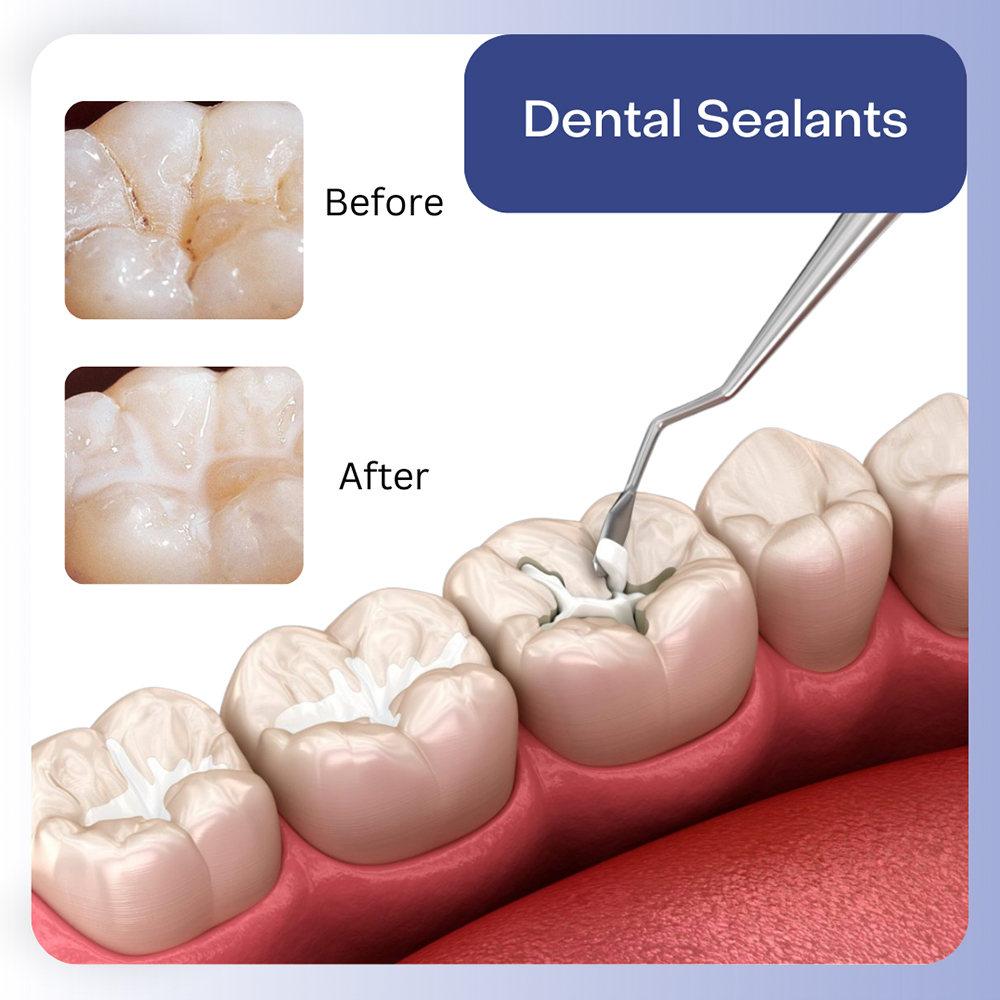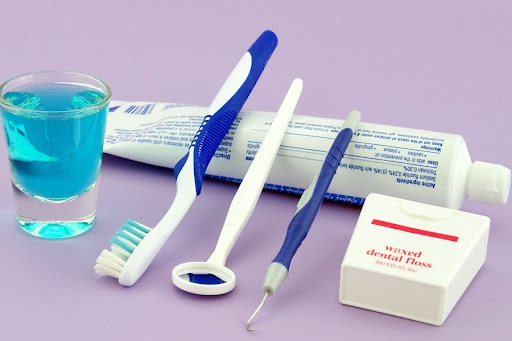Sealants: An Extra Layer of Protection Against Cavities

Tooth decay is one of the most common chronic conditions affecting people of all ages. While brushing, flossing, and regular dental checkups are essential for maintaining good oral health, sealants offer an additional layer of protection against cavities, particularly for children and teenagers. Dental sealants are a simple, cost-effective solution that can significantly reduce the risk of tooth decay by creating a physical barrier over the vulnerable surfaces of teeth.
In this comprehensive guide, we will explore what sealants are, how they work, their benefits, and why they are an excellent choice for preventing cavities. We’ll also delve into who should consider sealants, the procedure for applying them, their effectiveness, and how to maintain them for optimal dental health.
1. What Are Sealants?
Sealants are thin, protective coatings made of plastic or other dental materials that are applied to the chewing surfaces of the back teeth, primarily the molars and premolars. These teeth have grooves, pits, and fissures that can be difficult to clean with regular brushing and flossing. These crevices are prone to trapping food particles and bacteria, which can lead to tooth decay.
Sealants work by sealing these grooves, creating a smooth, easy-to-clean surface that blocks food and bacteria from settling in the tiny nooks and crannies. By providing this extra layer of defense, sealants significantly lower the risk of cavities forming in these high-risk areas.
2. How Do Sealants Work to Prevent Cavities?
Sealants act as a shield for teeth. The primary mechanism by which they prevent cavities includes:
- Physical Barrier: Sealants fill in the deep grooves and fissures on the tooth surface, creating a physical barrier that prevents food and bacteria from getting trapped.
- Smooth Surface: By smoothing out the chewing surfaces, sealants make it easier for the toothbrush bristles to glide over the teeth, ensuring more effective cleaning.
- Bacteria Blockage: Sealants block bacteria and acid from reaching the enamel, which is crucial for preventing decay. Without this protection, the acids produced by bacteria in the mouth can erode enamel and lead to cavities.
- Long-Lasting Protection: Once applied, sealants provide long-term protection, often lasting several years before needing a touch-up or reapplication.
3. The Benefits of Sealants: Why Choose Them?
Sealants offer a range of benefits, making them an excellent preventive measure against cavities. Here are some of the key advantages:
- High Effectiveness: Studies show that sealants can reduce the risk of cavities in molars by nearly 80%. For children who do not have sealants, their risk of developing cavities in their first molars is almost three times higher compared to those who have them.
- Quick and Painless Application: The process of applying sealants is fast, easy, and non-invasive. It does not involve drilling or removing any tooth structure, making it a comfortable experience for patients, especially children.
- Cost-Effective Preventive Care: Sealants are a cost-effective way to prevent cavities, which can lead to more complex and expensive dental treatments like fillings, crowns, or root canals. Investing in sealants can save money in the long run by avoiding these costly procedures.
- Ideal for Children and Teens: Sealants are particularly beneficial for children and teenagers who are at a higher risk of cavities. As their oral hygiene habits are still developing, sealants provide a much-needed layer of protection during these formative years.
- Versatility: While sealants are most commonly used for children, they can also be beneficial for adults who have deep grooves in their teeth or are at higher risk for decay.
4. Who Should Get Sealants?
Sealants are recommended primarily for children and teenagers, but they can also be beneficial for certain adults. Here’s a closer look at who should consider getting sealants:
- Children: Sealants are most effective when applied as soon as the first permanent molars erupt, usually around age 6. Second molars, which come in around age 12, should also be sealed as soon as possible.
- Teenagers: Adolescents can benefit from sealants, especially if they have deep pits and fissures in their teeth or a history of cavities.
- Adults: While sealants are less commonly applied in adults, they can still be useful for those who have particularly deep grooves in their teeth, are prone to cavities, or have not had sealants placed during childhood.
- Patients with Special Needs: Individuals who have difficulty maintaining regular oral hygiene, such as those with special needs or dexterity issues, may also benefit significantly from sealants.
5. The Sealant Application Process: What to Expect
Applying sealants is a simple, painless procedure that can be completed in a single visit to the dentist. Here’s a step-by-step guide to what you can expect during the application:
- Cleaning the Teeth: The dentist or dental hygienist will first clean the teeth thoroughly to remove any plaque or food particles from the surface. This ensures that the sealant can bond properly to the enamel.
- Preparing the Tooth Surface: After cleaning, the tooth is dried, and an acidic solution is applied to the chewing surface. This solution roughens the surface slightly, which helps the sealant bond more effectively to the tooth.
- Rinsing and Drying: The acidic solution is rinsed off, and the tooth is dried again. This preparation step is crucial for the sealant to adhere properly.
- Applying the Sealant: The sealant is then painted onto the tooth enamel, where it bonds directly to the surface. Some sealants harden on their own, while others require a special curing light to set them.
- Checking the Bite: Once the sealant has hardened, the dentist will check to ensure that it fits comfortably within your bite. Adjustments can be made if necessary.
- Final Inspection: The dentist will examine the sealant to make sure it covers the tooth surface completely and is securely in place.
6. How Effective Are Sealants?
Sealants are highly effective in preventing cavities, particularly on the chewing surfaces of the back teeth, where 90% of cavities occur in school-aged children. Research has consistently shown that sealants can reduce the risk of decay by up to 80% in molars, making them a valuable tool in preventive dental care.
- Longevity: Sealants can last from 5 to 10 years, although they may need to be checked and occasionally reapplied during regular dental visits. The durability of sealants depends on factors such as the patient’s oral habits, chewing forces, and overall oral hygiene.
- Success in High-Risk Populations: Sealants are especially beneficial for high-risk populations, such as children with a history of cavities, those who consume a lot of sugary foods and drinks, or those with limited access to regular dental care.
7. Maintaining Sealants: Tips for Longevity
While sealants provide excellent protection, proper care and regular dental checkups are essential to ensure their longevity and effectiveness. Here are some tips to maintain sealants:
- Regular Dental Visits: Continue to see your dentist regularly for checkups. During these visits, the dentist will examine the sealants to ensure they are intact and working properly.
- Good Oral Hygiene: Encourage consistent brushing and flossing habits, even with sealants in place. Sealants protect the surfaces they cover, but good oral hygiene is necessary to prevent decay on other parts of the teeth and gums.
- Avoid Hard and Sticky Foods: Limit consumption of hard foods like ice, hard candy, and sticky foods like gummy candies, which can potentially damage or dislodge sealants.
- Fluoride Use: Continue to use fluoride toothpaste and drink fluoridated water to help strengthen the entire tooth structure and provide additional protection against cavities.
8. Addressing Common Concerns About Sealants
While sealants are widely recommended, some individuals may have concerns or questions about their use. Here, we address some common concerns:
- Safety: Sealants are safe and effective for both children and adults. The materials used in sealants have been extensively tested and are approved by dental associations worldwide.
- BPA Exposure: Some people worry about BPA (bisphenol A) exposure from dental sealants. However, the amount of BPA in sealants is extremely low, much lower than what people are exposed to from other everyday sources. Sealants are considered safe, and the benefits far outweigh any potential risks.
- Effectiveness Over Time: Sealants are highly effective in the first few years after application, but their effectiveness may diminish over time as they wear down or are lost. Regular dental checkups will help monitor their condition, and reapplication can be done if needed.
9. Comparing Sealants to Other Cavity Prevention Methods
Sealants are just one tool in the arsenal against tooth decay, but how do they compare to other preventive measures?
- Brushing and Flossing: While brushing and flossing are critical for removing plaque and food particles, they often cannot reach the deep grooves on the chewing surfaces of molars. Sealants provide a complementary benefit by protecting these hard-to-reach areas.
- Fluoride Treatments: Fluoride helps to strengthen the entire tooth surface and is essential in preventing decay. However, sealants specifically target the chewing surfaces, where the majority of cavities in children occur.
- Healthy Diet: A balanced diet low in sugary and acidic foods is vital for cavity prevention. Sealants add an extra layer of defense against the sugars and acids that contribute to decay.
- Regular Dental Care: Regular visits to the dentist for cleanings, exams, and professional fluoride treatments are crucial. Sealants are a valuable addition to routine care, providing targeted protection that other methods cannot.
10. The Cost-Effectiveness of Sealants
Sealants are a highly cost-effective way to prevent cavities, especially when compared to the cost of treating dental decay. While the upfront cost of applying sealants may vary, the potential savings from avoiding fillings, crowns, and other restorative treatments make sealants a smart investment in oral health.
- Insurance Coverage: Many dental insurance plans cover the cost of sealants, especially for children. Some public health programs also offer sealants at low or no cost, making them accessible to a broader range of individuals.
- Preventive Value: The preventive value of sealants extends beyond cost savings. By preventing decay, sealants help avoid the discomfort and inconvenience of dental problems, contributing to better overall health and quality of life.
Conclusion: Embracing Sealants for Optimal Dental Health
Sealants are a simple yet powerful tool in the fight against tooth decay, offering an extra layer of protection for the most vulnerable areas of the teeth. With their proven effectiveness, ease of application, and long-lasting benefits, sealants are a valuable addition to any preventive dental care routine.
For parents looking to safeguard their children’s smiles, sealants provide peace of mind by significantly reducing the risk of cavities in those critical early years. For adults, sealants can still offer substantial benefits, particularly for those with a history of decay or challenges in maintaining optimal oral hygiene.
Ultimately, sealants represent a proactive approach to dental health, aligning with the broader goals of preventive care. By embracing sealants and incorporating them into regular dental visits, individuals can enjoy healthier, stronger teeth and a reduced risk of cavities for years to come. Sealants are a testament to the power of preventive care, proving that sometimes, the best solution is to stop problems before they start.
Related to read:
Best Oral Hygiene Practices For Optimum Oral Health.
Bruxism: Teeth grinding causes treatment and prevention.
How to keep your gums healthy and disease-free?
References
To ensure the information provided is accurate and up-to-date, the following sources were referenced:
- American Dental Association. (n.d.). Plaque and Tartar. Retrieved from ADA website
- Mayo Clinic. (n.d.). Dental Plaque. Retrieved from Mayo Clinic website
- National Institute of Dental and Craniofacial Research. (n.d.). Periodontal (Gum) Disease. Retrieved from NIDCR website










0 Comments on “Sealants: An Extra Layer of Protection Against Cavities”